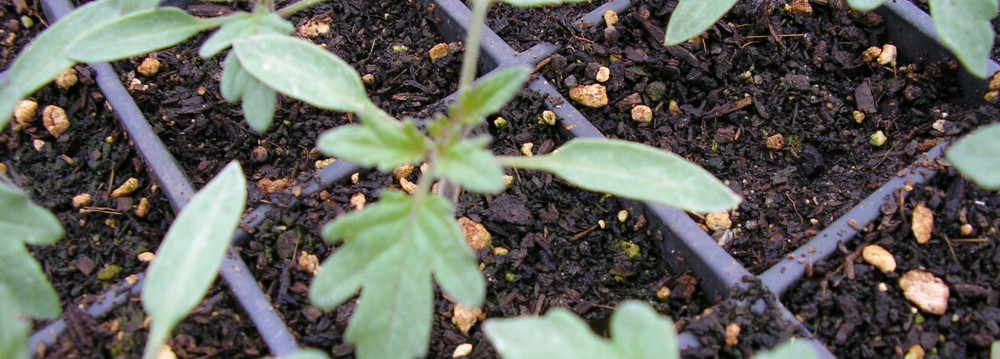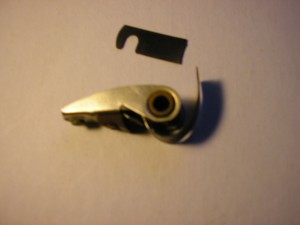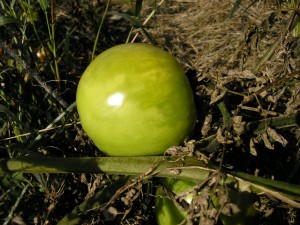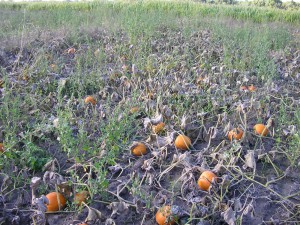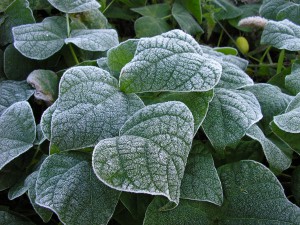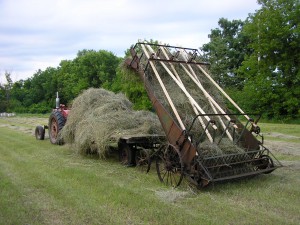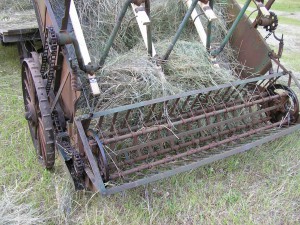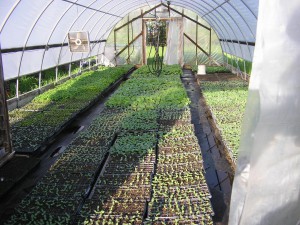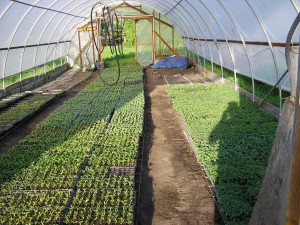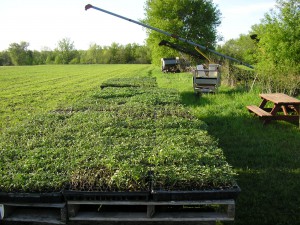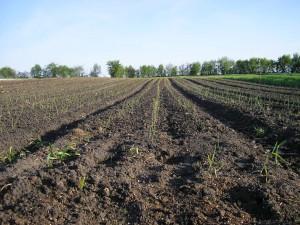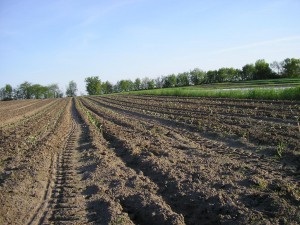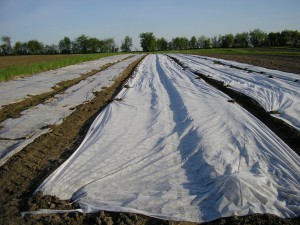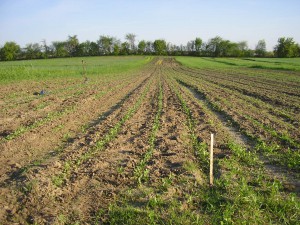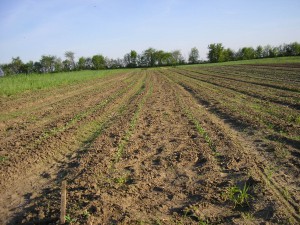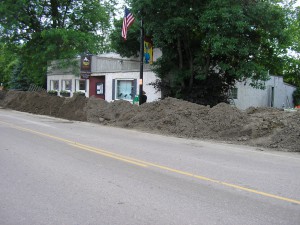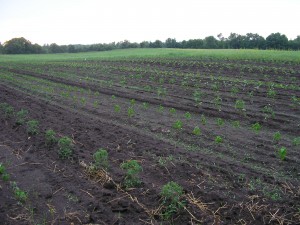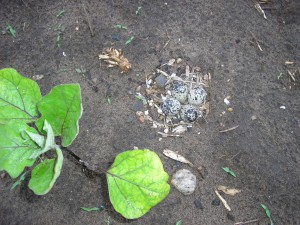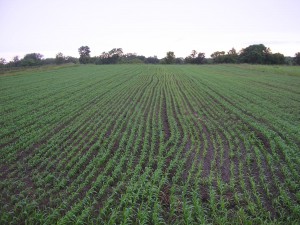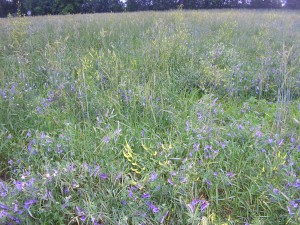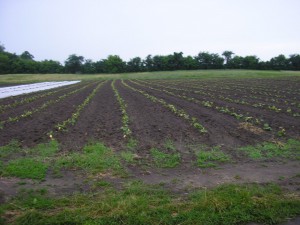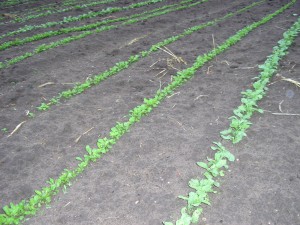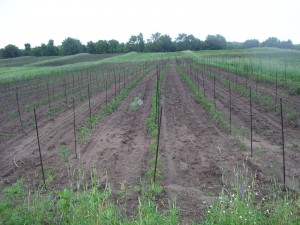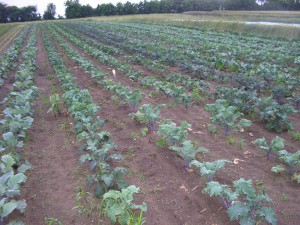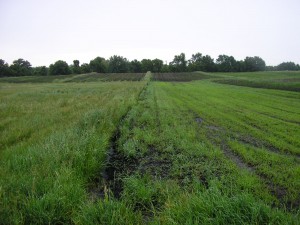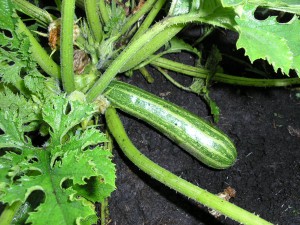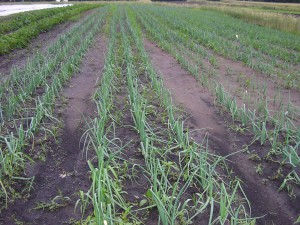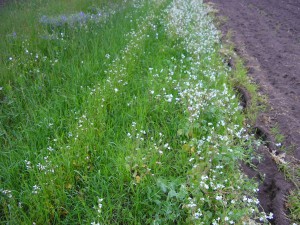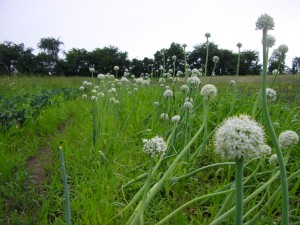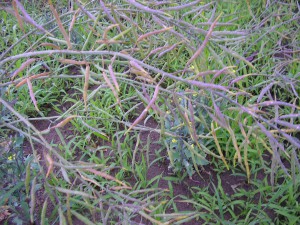Locally Adapted Seeds
This is mostly about vegetables but the ideas apply to just about any seed bearing plant.
Why Bother
Are your favorite varieties of Kale, Cauliflower, Onions, Peas, or Zucchini hard to find this year ? Are all those seeds, are all your seeds coming from someplace else ? Do you ever wonder why that is ?
Farmers have been selecting and saving seeds since the dawn of Agriculture. Why aren’t we doing that anymore ? There used to be 100s of regional seed companies, with dozens in Minnesota and Wisconsin. Now, three corporations control more than half of the worldwide seed business and none of them are located here.
I had been resistant to saving vegetable seeds for years. I didn’t want to wait until harvest time to find out that I had a seed crop failure. If two thirds of your purchased Delicata seed doesn’t emerge you know you have a problem, but you might have time to do something. If your Delicata crop matures to be some weird zucchini – spaghetti squash hybrid, you have seen them in your compost pile, it is more than a little too late to do anything about it.
There are several reasons that I have changed my mind. A big one is Quality.
As a matter of fact, I have had two thirds of my purchased Delicata seed fail to emerge. The seed may have germed in some lab somewhere, but they were not vigorous enough to emerge when planted in real dirt. I don’t want my money back for that seed. I want a truck load of Delicatas. Now I’m three weeks behind, One week for them to come up, a week of wondering ‘Are they coming up?’, and a week to get new seed. I don’t know where you are from, but I can’t afford to give up one sixth of my growing season on a tender hundred day crop.
In general I have been finding that overall seed quality has been decreasing.
Another reason is Availability. Good varieties disappear. And when a hybrid goes, it is gone.
I trialed red slicing tomatoes for three or four years, evaluated dozens of varieties, and came up with two organic hybrids that worked for me. Primetime and Paragon. They were both good tasting, solid, productive uniform varieties that worked in our low input conditions. One year only 25 seed packets of Primetime were available. That’s odd, but… The next year there was no seed available. Now what ? Another three or four years of trials for five or six years of production ? No way. I started trialing open pollinated tomatoes.
Reason number three – disease resistance.
In those trials I found that a lot of promising sounding open pollinated tomato varieties blighted out right away. It looked like someone had flame weeded out tomato field. You’ve seen it, heirlooms with these little wobbly stems with a little tuft of leaves on the tips. My experience has been that tomato plants without leaves are not very productive.
Along the same line is the issue is seed borne disease. A lot of arugula seed has a bacterial spot that causes watery looking spots that spread to cover most of the leaf. The disease spreads through rain splash and will infect most, If not all, the greens in the mustard family. The seed bags don’t come with a little warning label that says These seed are disease infested and will not produce a saleable crop’. We went from selling 15,000 bunches of arugula per year to under 2000 due to the disease. That’s not quite the result that I was looking for.
An even larger issue is Global Climate Chaos. In 20 years we have gone from not needing irrigation to having ten weeks in a season with out rain. not to mention that it does not rain in the summer anymore. When I was a kid, it would cloud up and rain straight down for a day or two. Not so much that it would run off, but a nice steady gentle rain. We don’t get that anymore. We get storms that dump two inches of rain in a couple hours, with winds that break off the trees. Last year we had three inches of rain every other week in June. Bad timing and a little more than we needed.
Looking back just a few years, in 2012 we had a very warm March, a freeze that the apple growers will not forget anytime soon, a hot July and a very dry summer. The spring of 2013 was cool and wet. There was a deh-REY-cho, a huge wind storm in June, July was hot. 2014 we had four months of January, lots of snow, the soil temperature did not get above 55° until mid June. There was so much rain last year that between 500,000 and 600,000 acres were not planted in Minnesota. Then we had a freeze on September 13th. This winter started off with a bang, but lately we have been in a drought. If this were summer people would be watering their trees. We have had weeks long stretches of record warm and record cold weather so far. How does this spring look ? Any guesses for this Summer ?
You could say that our climate is not very stable anymore. Seeds that are bred in moderate climates don’t do well here. The Olympic Peninsula is the world’s best place to grow brassica seed. It gets down to 25º in the winter and stays under 70° in the summer. Broccoli plants bred to a place like that don’t know what to do when the temperature hits 80°one week and falls into the 40°s the next week. Actually, it does, it buttons and bolts.
As I was wandering around the country last summer I found that the climate in seed growing areas is changing too. The Olympic Peninsula had record cold last winter and record heat in the summer. Remember all that missing kale seed ? The cold was hard on their overwintering brassicas. Their rainfall patterns are shifting too. It used to be dry until October, now it is raining in September. One grower I visited with had $200,000 worth of beet seed ready to harvest when it started to rain. They harvested maybe ¼ of it.
Back at home, plants on our farm are busy dealing with weeds. I know you are shocked, but we have weeds on our farm. Seeds grown in cushy, clean conditions may not have the competitive nature that gets them out of the ground and ready to go root to root with weeds to grab the nutrients they need. Weeds are not an ideal condition, but they are a fact of life.
Seeds grown in places where it never rains don’t express foliar diseases. Organic seed grown in input substitution systems don’t do well in cover crop based rotations. We need seeds that do well in cold, dry, hot, wet, all kinds of crummy conditions.
Access to productive, locally adapted seeds is important to me and I suspect they will be important to all of us in the next few years. It will be too late to start adapting seeds once the need is apparent. It takes time to adapt seeds to all the various conditions they will face in the future.
How to do it ?
There are three main steps in local seed production Adaption, Selection, and Saving. The seeds themselves take care of the adaption part. Most varieties have genes that they are not expressing. Our pro GMO friends are saying that farmers have been doing genetic modification for centuries. Remember Calgene’s Flavr Savr Tomato ™? Apparently the Calgene guys were clever enough to select for tomatoes had fish genes. Nonsense. Besides, everyone knows they should have been selecting for tomatoes with bacon and lettuce genes.
Plants do have enormous ability to adapt to their surroundings. They have to since migration is not really an option. If they couldn’t adapt, they would die out right away. Besides adaption there are a few lucky mutations, but they are rare. It is up to us to select the adaptions that are most beneficial. Selecting and saving seeds for even a year or two makes a huge difference in how well they do.
For example, we grew out some Misato Rose Radishes for seed in the spring. In the fall we planted them along side two rows of the same purchased seed. We only harvested radishes from the saved seed row. The purchased seed radish leaves were all yellow and spotty. The saved seed radish tops were bright green, they looked like new growth. The smallest saved seed radishes were the size of the largest purchased seed roots.
Years ago, I bought a bag of conventional Winter wheat seed, planted it and it got about a foot tall and yielded 9 bushels per acre. Norman Borlaug would have been so proud. Planting that seed in the fall produced a normal crop of three foot tall plants and about 30 bushels per acre under no input conditions.
Back to the tomato trials – I want a lot of big, good tasting, non cracking tomatoes on disease resistant plants. I started with a few open pollinated varieties that seemed like likely candidates – Peron Sprayless, Martian Giant, ORLST, and saved seed from the plants that weren’t all blighted out at the end of the season. After a few years of selecting and saving seeds I have productive tomato plants that look pretty good at the end of the season.
Another characteristic to select for is weed competition. Sometimes unintentionally, and more often that not our seed garden is neglected and, yes, more than a little weedy. If a crop is not going to thrive in less than perfect conditions, it has no place on our farm.
My latest disaster, selection experiment, was with emmer and einkorn, both ancient grains. Last spring was miserable, cold, wet, and went on forever. No weeds would germinate in stale bedded ground. The wheat started to come up and was completely overtaken by foxtail. In no time the bed looked like the most beautiful lawn. The grain matured and ripened. I forced my crew to hand harvest it, head by head. They were good sports about it and we got several pounds of seed. Those seeds are competitors.
That’s not the way it is supposed to happen, but what are the chances that we will have less than perfect planting conditions in the future ? This spring I’ll look to see if any of the grain self seeded. If it did, I’ll be sure to get back there and harvest it. It the mean time, I’m going to increase the seed stock that I have. It does well in tough conditions.
Open pollinated varieties are a good place to start, but hybrids are a great source of genetic material. They have some outstanding characteristics, but need to be selected and stabilized. Sometimes it takes years. Other times, I’m not so sure they were so hybrid in the first place. A fair number of the F2 pepper and eggplant varieties have around 15% off types.
I suppose that I should have told you this at the beginning, but I have no background or training in plant breeding and plan to trample all over the correct nomenclature. Defining a couple terms will make the rest of this easier to follow. F1s are the hybrids. They are the result of crossing two, typically inbred, parental lines. F2s are the seeds saved from hybrids. F3 seeds are saved from F2 plants and so on. At some point I suppose the new variety should be given a new name.
Like I said eggplant and peppers seems to be fairly true to type. Tomatoes are a little wilder. I really like Early Girl. Early Girl is an old Hybrid, a 1962 All American Selection winner. It has the right balance of sweet and acid flavors, and is reliably early. Saving the seeds of the Early Girl hybrid produces F2 plants that are very non uniform. F2 seeds from other hybrid tomatoes act about the same.
Some interesting things happened . The F2 Early Girl seed produced almost exactly two thirds normal tomato leaf plants and one third potato leaf plants. Usually you would expect 25 or 50% using basic genetics. In any case, there was an heirloom in the parent lines somewhere. We divided the plants by leaf type and created two populations. Plain leaf and potato leaf. Both types of the F2 plants had a variety of sizes, shapes, maturity, disease resistance. The next thing we noticed was that some of the plants were much earlier than the rest. They provided the seed for our F3 generations.
Both F3 generations produced the earliest ripe tomatoes last year (remember, it was a cold, wet season). The fruit was more uniform, but there was still a fair amount of variation in the size of the tomatoes. This time we let the plants sprawl and selected for disease resistance in addition to earliness. Some of the ‘reject’ plants had larger than normal fruit. It still tasted like an Early Girl, but bigger. There weren’t a lot of those so we mixed the fruit from the plain leaf and the potato leaf varieties to get a big enough sample. This will be the start of a third line of early tomatoes.
I should also say that some of these selections take place in our production areas. I’m not stuck on seed preservation. That’s where the Seed Savers Exchange excels. They do a great job. I want seeds that are better adapted to our conditions. you know that the heirloom seeds that your great grandmother saved ? It came out of her regular garden and she was selecting the best she had.
When you are saving tomato seed you should save it from at least 25 individuals to get a good genetic base. The number of individuals you need to form a good base varies with species and is not perfectly straight forward. In general, if the plants self pollinate like peas and lettuce, you don’t need as many, maybe as few as five individuals for a viable gene pool. If they are pollinated by insects, like kale, you need more and if they are wind pollinated you need a lot more, something like a couple hundred. Don’t get too hung up on this right away, you are probably not growing the only Lacinato kale seed on the planet.
When we plant tomatoes for seed selection I like to see 200 plants in the bed. That way we can reject three fourths of them and still have a bigger population than we need. It lets us be really selective. A lot of the tomatoes that we rejected for seed saving went into our CSA or to our restaurant accounts. Just because they ripened a little later does not make them bad tomatoes.
One thing that does need some attention is isolation. Every variety of kale will cross with any other variety of cabbage or kale, except Red Russian, which is a different species, closer to a rutabaga than a cabbage. Maybe this isn’t the best example, or maybe it is, but anyway unless you are breeding a new variety, you will be disappointed when next year’s Lacinato comes out looking like a kohlrabi.
In general plants in the same species will cross with each other. For example Brassica Oleracea contains Broccoli, Brussels Sprouts, Cabbage, Cauliflower, Collards, Kale, and Kohlrabi. They will all cross with each other. Red Russian is Brassica Napus and won’t cross with them.
Isolation distances depend on whether the plants self pollinate or are pollinated by insects or wind. If you are growing seeds for your own use it may not matter if a few of your hubbard cross with a buttercup. The result could be delicious. I know that Miami crossed with hubbard tastes good. But if you are selling produce, your customers could be put off by a 40 pound buttercup.
Mistakes happen and there are ways to fix them. Miami is an old variety of winter squash from the Miami people who live over in Illinois or Indiana. Somewhere along the line it got crossed with a hubbard. The original squash is three feet long and six inches in diameter. The miami-hubbard crosses may be a little football shaped or they may look like a pink hubbard.
I received some of the crossed up seed and was asked to see if I could straighten it out. There are a couple ways to do this. You know how squash have a tiny fruit under the female flower ? We are going to plant a block of this mixed up seed and look at the fruit under the female flowers. If they look like an off type we will pull out the whole plant. Once we have those cleaned out we will go through the bed and pick off all the pollinated female flowers and small squash even if they look perfect. The next day’s flush of flowers can only be pollinated by pollen from plants with the right looking squash.
As a back up we will hand pollinate several flowers to produce what should be purer seed. I’m sure that it will take several years to clean up this variety.
Messing with seeds is fascinating stuff. So a word of warning. Selecting and saving seed is a vicious cycle. The more you get into it, the more it pulls you in. The next thing you know, you have big tubs full of hundreds of bags of different kinds of seeds. It is not quite as bad as cat hording, but you know….
If you are finding yourself needing to know more, there are some very good books on the subject. To mention just a few that I have used: Seed to Seed by Susan Ashworth and The Organic Seed Grower by John Navazio both are very good and available at the MOSES bookstore. A book that is available for free on line is Return to Resistance by Raoul Robinson. It is less technical and more inspirational.
So then what ?
And finally, My vision is for local seed company that produces and distributes well adapted, resilient, productive vegetable varieties. I have no idea how this would work. It could be a producers co-op or a straight ahead seed company. I do know that it will be a collaboration of several farms due to the need to produce more than one kind of kale, cabbage, and onion seed. Lets start now.
Thank you.
